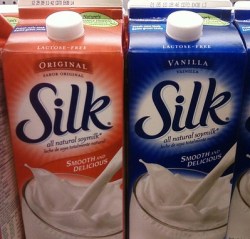If you drink soy milk, odds are high that you drink Silk. Found in the refrigerator aisle, the brand can be credited with bringing this non-dairy beverage to the mainstream around a decade ago. It’s probably not surprising then that Silk’s umbrella company, White Wave, was founded in the 1970s by Buddhist hippies (because who else was drinking soy milk in the ’70s?) but sold for $190 million to corporate behemoth Dean Foods (maker of the Horizon line of organic dairy, as well as many other brands you may know) in 2002.
Silk also makes a really interesting case study of consolidation in the organics industry. You see, for years all the soy milk it sold was certified organic. And by the mid-2000s, the brand had become such a powerful market force that it was keeping a significant portion of organic soy farmers in business.
Then, in 2009, Dean executives made a subtle, but important change; they stopped making their “regular” blue-carton product with organic soybeans, switching instead to non-GMO, conventionally grown soy. They dropped the word “organic” from their label, and for those who were paying close enough attention to notice the shift, they created a special organic line. (Dean did the same thing with milk and yogurt, rolling out a more affordable “natural” line in a way that splintered the market.)
From a consumer’s perspective, the change made little difference. Yes, it took a bit more concentration in the grocery aisle, but for most people, “natural” was close enough. And hey, it still looked healthy, right?
But on the farm, the effects of this simple shift were surprisingly dramatic. According to a new report on consolidation in the food industry from the nonprofit organization Food and Water Watch (FWW), Americans drank an estimated 67 million gallons of organic soy milk in 2008. By 2009, consumption dropped to a measly 18 million gallons. And while not all of this can be attributed to Silk, the brand did account for around 75 percent of the market at the time — a fact that’s pretty damning no matter how you do the math.
The result? According to FWW, “a 49 million gallon decline in organic soymilk reduced the market for organic soybean farmers by 1.2 million bushels of food-grade soybeans the first year.” That’s 32,400 acres of organic production — gone in one year! Meanwhile, the cultivation of non-genetically engineered but conventionally raised soybeans increased by nearly 1 million acres in 2009. As you might guess, this change hit farmers where it hurt. FWW writes:
Non-biotech soybeans cost about $11 to $12.50 per bushel in 2009 versus $19 for organic soybeans. Assuming an average price differential of $7.25, Dean saved — and organic farmers lost — an estimated $8.7 million dollars that year.
The Silk story is one of several examples FWW has singled out to talk about the way a few big companies now control a great deal of our food. According to a 2007 study [PDF] from the University of Missouri, the four largest companies controlled 82 percent of the beef packing industry, 85 percent of soybean processing, 63 percent of pork packing, and 53 percent of broiler chicken processing. In fact, so much consolidation has taken place throughout the food chain that it can be difficult for any one person to fathom the true effects. That’s why FWW has been working to spell out exactly what it means to have so few companies owning, and controlling, the food production process for years. This report is just the latest iteration of that work.
“When you talk to farmers and folks in rural communities, their experience is that consolidation has changed their economies, they’ve just never had the papers to prove it,” says FWW’s Patty Lovera. “Then you talk to folks in the government and in industry and far too many agriculture economists, and they’ll say: ‘No, no, it’s fine. Everyone’s winning; it’s more efficient this way.’ So we wanted to take that on.”
In addition to soy milk, the FWW report tackles pork in Iowa (where consolidation has led to twice the production yet much fewer dollars for farmers), dairy in New York state (where most small producers have been pushed out), chicken in Maryland (where big poultry farms have driven out other kinds of farming), and fruit and vegetable production in California’s Central Valley, where “the global reach of transnational agribusiness giants can serve to drain wealth from rural economies.”
Because this kind of consolidation is nearly invisible to urbanites (i.e. the bulk of our population), it can be difficult for many of us to get fired up about food monopolies. But the dismal economic state of rural America might also have something to do with why so many of us are living in cities these days; most of us don’t feel like we have much choice. FWW’s report reads:
The rising economic concentration has contributed to the decline in the number of farms and the increased size in the farms that remain. Communities with more medium- and smaller-sized farms have more shared prosperity, including higher incomes, lower unemployment and lower income inequality, than communities with larger farms tied to often-distant agribusinesses.
Sadly, the latter has become the norm.
But it’s worth keeping in mind that — even if they’re miles away — there are still people, and whole communities, behind the soy milk, pork, milk, and vegetables we’re eating in cities. It’s safe to say their lives are probably harder because of consolidation; and they have much less market-based motivation to care for the earth than ever before.
“We hope to show that it’s not just ‘things change, farmers go in and farmers go out,'” says Lovera, of the organization’s recent findings and analysis. “We wanted to point to the actual causality, and say, ‘now that was a consolidation event, and everything was different afterwards.’”




